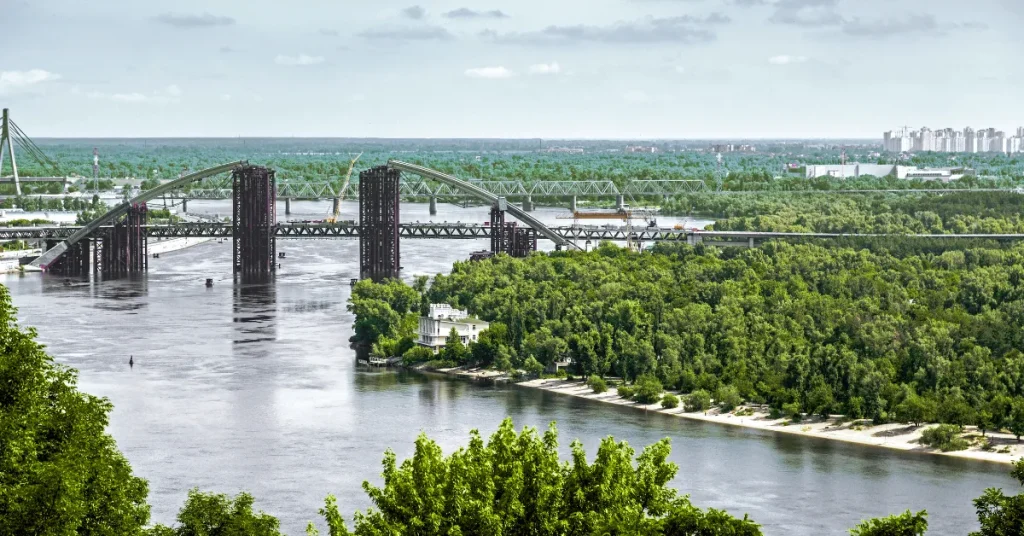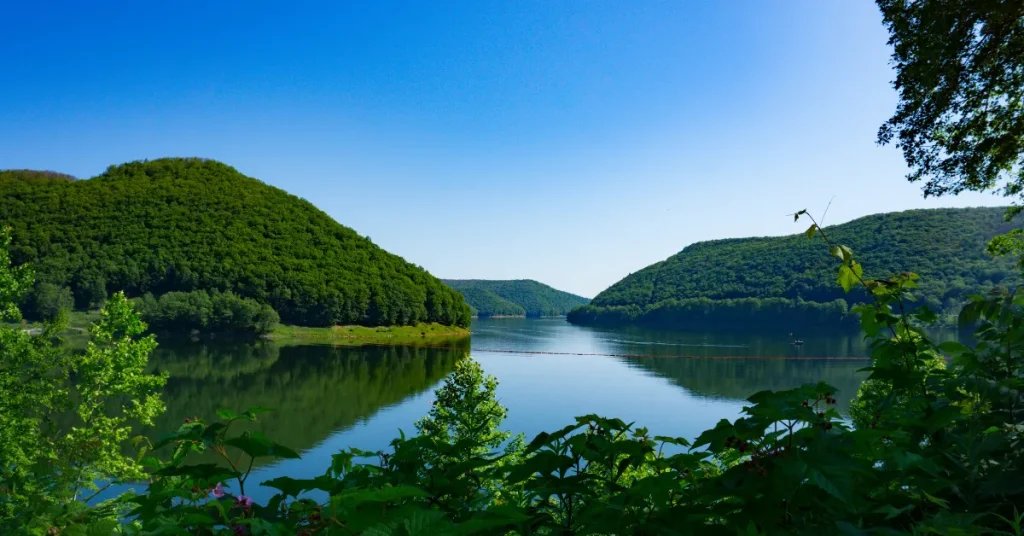The Allegheny River has an average depth of about 4 to 5 feet but can reach depths of over 30 feet in certain areas. The deepest points are often found near the dams and locks.
Nestled in the rugged landscapes of the northeastern United States, the Allegheny River stretches for 325 miles, carving its way through Pennsylvania and New York.
As a critical tributary of the Ohio River, its depths vary dramatically from shallow riffles that dance over rocks to profound pools near human-made structures.
Anglers, boaters, and outdoor enthusiasts frequent the Allegheny, lured by its natural beauty and the diverse opportunities it provides for recreation and wildlife observation.
The river’s ecosystem supports a rich array of life and is integral to the region’s water quality and habitat health. Depth fluctuations are crucial for its navigability, shaping the interactions between the river and those who live alongside it.

Allegheny River Depths Revealed
Have you ever wondered how deep the Allegheny River is? This mighty river holds secrets beneath its surface. From calm shallows to mysterious depths, the Allegheny River has a variety of underwater landscapes.
Measuring The Depths
The depth of the Allegheny River is not constant. It changes based on location and weather conditions.
Scientists measure depth using sonar technology. They send sound waves to the riverbed and record the time it takes to bounce back.
- Shallow areas can be less than 3 feet deep.
- Deeper sections range up to 30 feet or more.
- Depth data helps with navigation and habitat studies.
Comparing River Profiles
The Allegheny’s profile is unique. Let’s compare it with other rivers!
| River Name | Average Depth (feet) | Max Depth (feet) |
| Allegheny River | 4-5 | 30+ |
| Mississippi River | 9-12 | 200 |
| Ohio River | 15 | 85 |
Rivers like the Mississippi are much deeper. The Ohio River is deeper on average but has a lower maximum depth. Each river has unique depth patterns, which affect the ecosystem and human activities.
Navigating The Waters

The Allegheny River holds mysteries beneath its surface. It winds its way through New York and Pennsylvania, offering boaters, shippers, and anglers a playground of varied depths and challenges.
Journeying along the Allegheny requires knowledge of its character to ensure safe and enjoyable experiences.
Boating And Shipping Challenges
Every boater needs to stay alert along the Allegheny. Depths can vary greatly, from shallow areas that threaten to ground vessels to deeper channels that allow for safe passage. Charting a course can be tricky, and local knowledge is invaluable in avoiding the hazards:
- Shallow zones – some sections are as shallow as 2-3 feet
- Submerged objects – logs and debris require careful steering
- Navigation buoys – essential guides through changeable depths
Boaters and shippers must consult river charts and watch for daily updates on water levels to navigate safely.
Fishing Hotspots And Depths
The Allegheny’s waters brim with fish, drawing anglers eager for a catch. But where are the fish biting? Knowing the river’s depth helps find the hotspots:
| Fishing Area | Average Depth | Fish Species |
| Near Dams | 10-30 feet | Walleye, Bass |
| Winding River Bends | 6-20 feet | Trout, Northern Pike |
| Quiet Backwaters | 4-15 feet | Catfish, Carp |
Fish tend to gather where the water churns or settles. Anglers look for drop-offs and hiding spots that attract fish. Depth finders and river maps are tools that lead to the day’s best catches. Always check local fishing reports before heading out.
Aquatic Life In The Allegheny
The Allegheny River, a testament to nature’s splendor, teems with vibrant aquatic life. Its depths play home to a diverse array of species, each uniquely adapted to the river’s flow and resources.
From fish to amphibians to plants, the Allegheny is a vital habitat beckoning exploration.
Species Adapted To The Depths
Beneath the surface, a remarkable world exists. An abundance of fish like Smallmouth Bass and Walleye navigate the Allegheny’s currents, showcasing their depth-driven adaptations.
Mussels anchor securely amidst the riverbed, filtering water to feed and cleanse the ecosystem.
- Channel Catfish: Masters of the murky depths
- Northern Pike: Ambush predators with a taste for shallow waters
- Muskellunge: The elusive giants of the Allegheny
Impact Of Depth On River Ecology
The river’s depth directly influences its ecological character. Light penetration decreases with depth, shaping the habitat and types of life found. Aquatic plants thrive in shallower zones, while deeper areas support different life forms.
| Zone | Depth (ft) | Life Forms |
| Sunlit | 0 – 6 | Algae, Trout, Freshwater Sponges |
| Twilight | 6 – 12 | Crustaceans, Some Fish Species |
| Dark | 12+ | Catfish, Certain Mussels |
Species survival and reproductive strategies shift with the river’s depth. Adaptations to limited light and pressure variances are critical. These adaptations ensure the ongoing vibrancy and sustainability of Allegheny’s aquatic community.
Humanity’s Influence
The Allegheny River, a lifeblood for many ecosystems and communities, has depth that varies. Yet, one cannot ignore Humanity’s Influence on this storied waterway.
From early settlers to the present-day conservationists, humans have left an indelible mark on the river’s depths and health.
Historical Use And Alterations
The Allegheny River’s journey through time shows a river sculpted by human need and innovation. Historical use ranges from transportation pathways for tribal nations and early European settlers to the backbone of industrial development.
- Dams built for navigation and flood control
- Deforestation for agriculture and urban development
- Pollution from industrial activities, altering water quality and depth
During the 19th and 20th centuries, industries along the banks dramatically changed the river’s natural flow. Channel modifications and alterations led to a controlled, yet at times artificially deep, waterway.
Contemporary Conservation Efforts
In recent times, an emphasis on nurturing nature has emerged. Conservation efforts aim to restore and maintain the Allegheny’s health for generations to come.
- Water quality improvements through reduced industrial discharge
- Restoration projects to stabilize riverbanks and replenish habitats
- Educational programs to foster community involvement in river care
Organizations and government bodies pursue these efforts diligently. These efforts ensure the river’s depths remain not only navigable but vibrant and full of life.
Mysteries Beneath The Surface of Allegheny River

The Allegheny River whispers stories from its depths, beckoning the curious to uncover its secrets. This mighty river holds mysteries beneath its surface that spark the imagination of both locals and visitors alike.
Its depths vary, concealing old shipwrecks, forgotten treasures, and perhaps even unknown creatures in its murkier parts. Let’s dive into the unknown and explore the legends that make the river more than just a body of water – but a source of endless fascination.
Unexplored Areas
Despite its frequent use and importance in the region, significant portions of the Allegheny River remain shrouded in mystery. Diving expeditions and scientific studies have only touched the surface, leaving the deepest parts untouched:
- Beneath the murky waters, there may be undiscovered species of fish and plants.
- Hidden caverns and underwater channels could tell stories of the land before time.
- Sections near the riverbed possibly hold remnants of past industrial activities.
Legends And River Lore
The Allegheny is not just a river; it’s a keeper of tales. With every wave and ripple, it carries legends that have been passed down through generations:
- Ghostly ships are said to appear on foggy nights, only to vanish into thin air.
- Local folklore speaks of the Green Man of the River, an ethereal figure protecting the waters.
- Tales of buried treasure near its banks capture the imagination of treasure hunters.
These stories continue to intrigue and provide an eternal sense of wonder about what truly lies beneath the ripples of the Allegheny River.
FAQs About How Deep Is Allegheny River
What Is The Average Depth Of The Allegheny River?
The average depth of the Allegheny River is approximately 3 to 5 feet. However, it can reach depths of over 30 feet in certain areas, particularly near the dams.
Where Is The Deepest Point Of Allegheny River Located?
The deepest point of the Allegheny River is near the Kinzua Dam. In this area, the depth can exceed 100 feet, making it the deepest section along the river’s course.
How Does The Depth Of Allegheny River Affect Navigation?
The depth of the Allegheny River plays a crucial role in navigation. Shallower areas may limit the size of boats able to navigate, while deeper sections accommodate larger vessels. Seasonal changes can also impact depth and navigability.
Can You Swim In The Allegheny River?
Swimming is possible in the Allegheny River, but it’s advised to do so with caution. The river’s depth varies, and there may be strong currents. Always check local guidelines and water conditions before swimming.
Conclusion
Exploring the depths of the Allegheny River reveals a fascinating journey between shallow banks and deeper channels.
Whether you’re a curious visitor or an avid angler, understanding the river’s depth enriches your experience. Embrace the Allegheny’s varying underwater terrain – it’s a vital part of its unique ecosystem.
Let the river’s flow guide your next adventure.
Resources:
1. https://www.rivers.gov/rivers/river/allegheny
